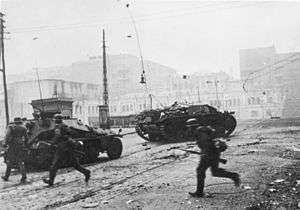First Battle of Kharkov
The 1st Battle of Kharkov, so named by Wilhelm Keitel,[3] was the 1941 battle for the city of Kharkiv (Kharkov in Russian[4]) (Ukrainian SSR) during the final phase of Operation Barbarossa between the German 6th Army of Army Group South and the Soviet Southwestern Front. The Soviet 38th Army was ordered to defend the city while its factories were dismantled for relocation farther east.
The German 6th Army needed to take the city in order to close the widening gap to the German 17th Army. By 20 October the Germans had reached the western edge of the city, it was taken by the 57th Infantry Division by 24 October. At that time, however, most of Kharkiv's industrial equipment had been evacuated or rendered useless by the Soviet authorities.
Importance of Kharkiv
Kharkiv's railroad system
In the autumn of 1941, Kharkiv was considered one of the Soviets' most important strategic bases for railroad and airline connections. It not only connected the east-west and north-south parts of Ukraine, but also several central regions of the USSR including the Crimea, the Caucasus, the Dnieper region, and Donbas.
Military importance
Kharkiv was one of the largest industrial centers of the Soviet Union. One of its greatest contributions was the Soviet T-34 tank that was both designed and developed at the Kharkiv Tractor Factory. It was considered to be the most powerful tank plant in the country. Other factories that were located in the city included the Kharkiv Aircraft Plant, Kharkiv Plant of the NKVD (FED), and the Kharkiv Turbine Plant. Military products that were in Kharkiv before the battle started included: tanks, Su-2, artillery tractors, 82 mm mortars, sub-machine guns, ammunition, and other military equipment. The main objective for the German troops was to capture the railroad and military factories, thus they desperately tried to keep the industrial area of Kharkiv intact. Adolf Hitler himself stressed the importance of those military plants stating: "… The second in importance is south of Russia, particularly the Donets Basin, ranging from the Kharkiv region. There is the whole basis of [the] Russian economy; if the area is mastered then it would inevitably lead to the collapse of the entire Russian (sic - Soviet) economy…[5]"
Population of Kharkiv
Kharkiv was one of the most populated Soviet cities during World War II. It was rated at 901,000 people on 1 May 1941. In September 1941 the population skyrocketed to 1.5 million people, due to numerous evacuees from other cities. After multiple attacks and many deaths, the population of Kharkiv decreased to 180 – 190,000, which was the size after the retaking of the city in August 1943.[6]
Before the battle
The aftermath of Kiev
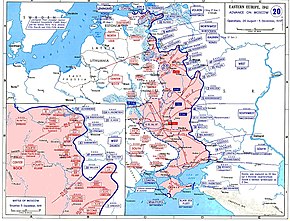
After the Battle of Kiev, Army Group Center was ordered to redeploy its forces for the attack on Moscow, and so the 2nd Panzer Group turned north towards Bryansk and Kursk. Army Group South, and in particular Walther von Reichenau's 6th Army and Carl-Heinrich von Stülpnagel's 17th Army took the place of the panzer divisions. The main offensive formation of Army Group South, Paul Ludwig Ewald von Kleist's 1st Panzer Group, was in the meantime ordered south for a drive to Rostov-on-Don and the Caucasian oilfields, following Führer Directive No. 35. The burden of processing Kiev's 600,000 prisoners of war (POWs) fell upon the 6th and 17th Armies, so while the 1st Panzer Group secured the German victory in the Battle of Melitopol, these two armies spent the next three weeks regrouping.
Stavka (Soviet High Command), needed to stabilize its southern flank and poured reinforcements into the area between Kursk and Rostov, at the expense of its forces in front of Moscow.[7] The Southwestern Front, which had been destroyed during the battle of Kiev, was re-established under the command of Marshal Semyon Timoshenko, one of the more capable Red Army commanders. The 6th, 21st, 38th and 40th Armies were reconstituted almost from scratch.
Approaching Kharkiv
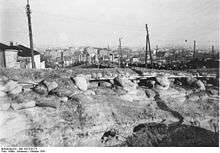
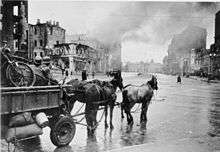
With the Battle of Moscow under way, the Germans had to protect their flanks, and on 6 October von Reichenau advanced through Sumy and Okhtyrka in the direction of Belgorod and Kharkiv. On the same day, the 17th Army commenced its offensive from Poltava towards Lozova and Izyum to protect the lengthening flank of the 1st Panzer Army (formerly the 1st Panzer Group). The 6th Army (Rodion Malinovsky) and 38th Army (Viktor Tsiganov) failed to conduct a coordinated defense and were beaten back. In the lead up to the Battle of Moscow, the Red Army suffered a big defeat at Vyazma and Bryansk, with 700,000 casualties. The few reserves available were desperately needed to defend the Soviet capital, not the Southwestern Front. With no reserves to plug the breach, the Stavka was forced fall back to Voronezh to prevent the collapse of the southern flank.[8]
Although the main objectives of the German Army before winter fell were to capture Leningrad, Moscow and the approaches to the Caucasian oilfields, Kharkiv was an important secondary objective. Besides the need to protect the flanks of its motorized spearheads, the German Army high command, Oberkommando des Heeres (OKH), also saw the importance of Kharkiv as an industrial center and railroad hub. Capturing the city meant that the Southwestern and Southern Front had to fall back on Voronezh and Stalingrad as their major transport hubs. When, in the second week of October, the rainy season of the Rasputitsa (the 'mud' season) and the poor logistics in the area between the Dnepr and the front, (all the bridges had collapsed during combat and ice threatened the pontoons), caused the offensive to stall.[9] Hitler allocated resources from the 17th Army to the 6th Army to ensure the capture of Kharkiv. This, however, weakened the 17th Army's effort to protect the flank of the 1st Panzer Army and contributed to the German defeat at the Battle of Rostov.[10] After 17 October, night frost improved the roads, but snow storms and the cold started to hamper the Germans, who were insufficiently equipped for winter operations (the German Army had planned that Barbarossa would be over before winter fell).
Course of the battle
Preparing to take the city
The task of assaulting Kharkiv itself was given to the LV. Armeekorps commanded by General der Infanterie Erwin Vierow. This corps had at its disposal the 101. Leichte-Division, commanded by Generalleutnant Josef Brauner von Haydringen and coming in from the north, the 57. Infanterie-Division, commanded by Generalmajor Anton Dostler and coming in from the south, and the 100. Leichte-Division, which did not take part in the battle. Sturmgeschütz-Abteilung 197, commanded by Hauptmann Kurt von Barisani had two of its three batteries attached to the 57. Infanterie-Division to provide close fire support during the assault.
For the defense of Kharkiv, the 216th Rifle Division had been reformed there after its destruction at Kiev. It received little to no support from other divisions or from higher command formations, because the 38th Army was in the process of a strategic retreat and the defense of Kharkiv was only necessary as long as its factory equipment had not been completely evacuated.
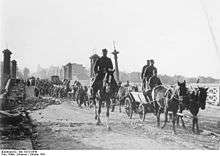
Battles on the western edge of the city (20–23 October)
57th Infantry Division plus a Panzer Brigade
101st Light Division
By 21 October the 101st Light Division had reached a line about six kilometers west of Kharkiv. The 228th Light Regiment spearheaded the division, its 1st and 3rd battalions taking up defensive positions on the front, with the 2nd battalion in reserve. On 22 October the regiment was ordered to conduct reconnaissance to determine the enemy's strength. That same day at noon the regiment was attacked by a Soviet infantry battalion supported by tanks. The attack was repulsed and two tanks were disabled. That night the recon information was transmitted by radio to the Division HQ. The 216th Rifle Division had occupied the western edge of the city, with machine gun nests, mortar pits and minefields in place.
For the attack, the 3rd battalion (the regiment's right flank), was reinforced with two guns from the division's artillery, The 85th Artillery Regiment, a company of engineers and an 88 mm anti-aircraft gun. The 2nd battalion received the same reinforcements, but without the AA gun. The 1st battalion acted as the regimental reserve. The first battalion of the 229th Light Regiment would protect the left flank of the 228th. The attack hour was set at noon, in conjunction with the 57th Infantry Division.
At 11:00 hours, a liaison was established between the 85th Artillery and the 228th Light Regiments. The artillery was not ready at the time designated, so the attack had to be postponed. In the meantime the anti-tank company, who had been stuck in the mud at the rear, finally arrived at the front and was ordered to assign one 37 mm AT-gun platoon to every frontline battalion. At 14:25, the artillery was ready and the attack hour was set at 15:00.
Assault on the city (23–24 October)
The evacuation of industrial enterprises started before the Germans had a chance to attack. By 20 October 1941 it was virtually completed. Three-hundred and twenty trains were sent with the equipment from 70 major factories. Kharkiv was taken by von Reichenau's 6th Army, on 24 October 1941.
Occupation of Kharkiv
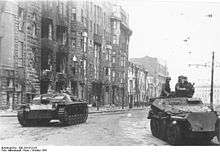
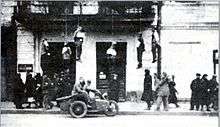
The city was subject to its first occupation during the war, which lasted until 16 February 1943. The city never became part of Reichskommissariat Ukraine because of its proximity to the front. The staff of the LV Army Corps acted as the occupational authority, using 57. ID as an occupation force. Generalmajor Anton Dostler was Stadtkommandant until 13 December, when he was succeeded by Generalleutnant Alfred von Puttkamer, and Kharkiv was transferred to the Heeresgebiet of the 6th Armee and put under the joint authority of the Stadtkommandant and Field Command 757.
German troops acting under the authority of the Reichenau-Befehl of 10 October (effectively an order to kill anybody associated with communism) terrorized the population that was left after the battle. Many of the Soviet commanders' corpses were hung off balconies to strike fear into the remaining population. Many people began to flee, causing chaos.
In the early hours of 14 November, multiple buildings in the city center were blown up by time-fuses left by the retreating Red Army. Casualties included the commander (Generalleutnant Georg Braun) and staff of the 68th Infantry Division. The Germans arrested some 200 civilians (mostly Jews) and hanged them from the balconies of large buildings. Another 1,000 were taken as hostages and interned in the Hotel International on Dzerzhinsky Square. All of these war crimes were committed by frontline Heer commanders, and not by SS troops.[12]
On 14 December, the Stadtkommandant ordered the Jewish population to be concentrated in a hut settlement near the Kharkiv Tractor Factory. In two days, 20,000 Jews were gathered there. Sonderkommando 4a, commanded by SS-Standartenführer Paul Blobel, of Einsatzgruppe C started shooting the first of them in December, then continuing to kill them throughout January in a gas van. This was a modified truck that fitted 50 people in it; the van drove around the city and slowly killed the people that were trapped in it with carbon monoxide that was emitted from the vehicle itself and channeled into an airtight compartment. The victims died by a combination of carbon monoxide poisoning and suffocation.[13][14]
The German Army confiscated large quantities of food to be used by its troops, creating acute shortages in the Ukraine. By January 1942 around one-third of the city's 300,000 remaining inhabitants suffered from starvation. Many would die in the cold winter months.[15]
As a result of the battles in Kharkiv, the city was left in ruins. Dozens of architectural monuments were destroyed and numerous artistic treasures taken. One of the Soviet Unions's best known authors, Aleksey Nikolayevich Tolstoy wrote: "I saw Kharkiv. As if it were Rome in the 5th century. A huge cemetery…"
References and footnotes
- According to Glantz 2001, p. 247-248, the strength of the weakened Southwestern Front on 30 September was 147,110 men, mostly survivors from the battle of Kiev. Reïnforcements sent after this date include several NKVD divisions and brigades fighting as regular ground units.
- According to Glantz 2001, p. 248, the losses of the Southwestern Front from 30 September to 30 November numbered 96,509 men, including 75,720 irrecoverable (dead, missing or captured) and 20,789 sick and wounded.
- see The memoirs of Field-Marshal Keitel. Edited with an introduction and epilogue by Walter Gorlitz. Translated by David Irving, William Kimber, London (1965)
- Kharkov is the Russian language name of the city (Kharkiv the Ukrainian one); both Russian and Ukrainian were official languages in the Soviet Union (Source:Language Policy in the Soviet Union by L.A. Grenoble & Eastern Europe and the Commonwealth of Independent States by Routledge)
- Memoir of Kharkiv’s History
- Kharkiv News
- Glantz 2001, p. 140.
- Glantz 2001, p. 151-152.
- Margry 2001, p. 5
- Kirchubel 2003, p. 76.
- Margry 2001, p.6
- Margry 2001, p. 8
- Ukrainian Historical Journal
- Margry 2001, p. 8-9
- Margry 2001, p. 9
Sources
- Chen, Peter (2004–2007). "First Battle of Kharkov". World War II Database. Retrieved 8 February 2007.
- Glantz, David M. (2001). Before Stalingrad, Tempus Publishing Ltd. ISBN 0-7524-2692-3
- Kharkov News
- Kiessling, Hannes (2007–2011). Bericht über die Einnahme von Charkow, 57.Infanterie-Division. Retrieved 14-08-2011
- Kirchubel, Robert (2003). Operation Barbarossa 1941: Army Group South, Praeger Publishers. ISBN 0-275-98282-3
- Margry, Karel (February 2001). "Kharkov", After The Battle, Issue 112, p. 3–45
- Memoir of Kharkov’s History
- Ukrainian Historical Journal
